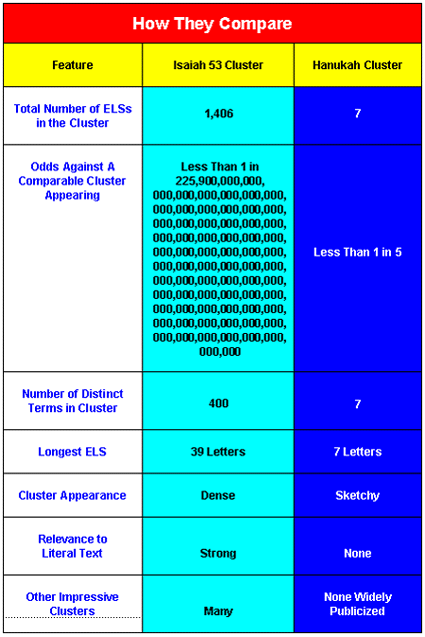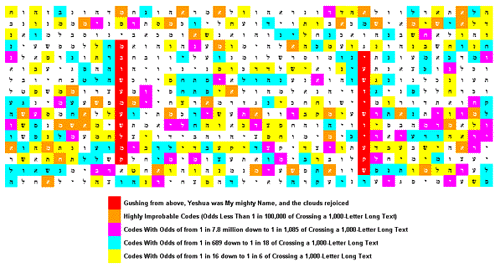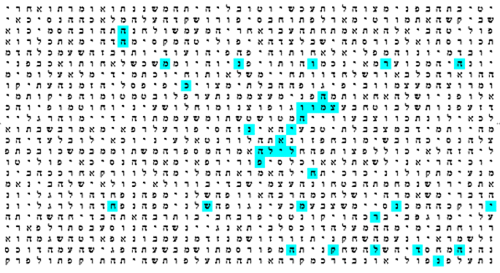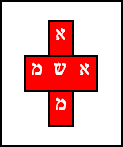ADDITIONAL PROOF THAT AUTHENTIC CODES ARE BEYOND CHANCE ETC.
New Evidence Overturns Skeptics' Case
Explosive 1,400+ ELS Cluster in Isaiah 53
Dwarfs Skeptics' Counter-Example
Opponents of Bible codes say that you can find meaningful clusters in any book. To support their case, they presented an example of a code cluster about Hanukah they found in Tolstoy's War and Peace.
While this example was fairly comparable to clusters Bible code researchers had presented back then, our researchers have unearthed clusters that look like mountains compared to the molehill of the Hanukah example. In this report we present a detailed side-by-side comparison of the Hanukah example and the most extensive cluster researchers have located to date-- the explosive Isaiah 53 codes. In short, what skeptics told us three years ago is now completely out of date.
[QX: RED COLOR EMPHASIS IN ORIGINAL]
------------------------------------------
COMPARING CLUSTERS:

The Skeptics' Arguments Don't Hold a Hanukah Candle
to Extensive Evidence of the Reality of Bible Codes
Ever since the Bible codes were introduced, skeptics have been saying, "Oh, well, you can find codes like that in books like War and Peace and Moby Dick."
In fact, skeptic Brendan McKay even went so far as to collect a fairly impressive looking cluster of codes about Hanukah in a Hebrew translation of War and Peace. His findings have been posted for some time at
HERE: http://wopr.com/biblecodes/TheCase.htm
We took the time to examine this cluster and compare it to a truly significant one—the Isaiah 53 cluster.
The results, detailed below, reveal the irrelevance of the Hanukah example. The argument that you can find other supposedly meaningful code clusters in books other than the Bible—and the Hanukah cluster—have done much to reduce the credibility of Bible codes in the eyes of many. In the case of some codes presented in best-selling books this was appropriate, because it would be misleading to attach significance to clusters that are comparable to the Hanukah example. For this contribution, we owe Dr. McKay a debt of gratitude.
The Expanded Isaiah 53 Cluster Vs. the Initial Isaiah 53 ELS
In the forward to Yacov Rambsel's book, Yeshua, published in 1996, the author cites one ELS translated as "Yeshua (Jesus) is my name" from Isaiah 53. Grant Jeffrey also refers to this ELS in his 1996 book, The Signature of God. These authors cited this ELS as significant evidence that Jesus was the messianic figure prophesied in Isaiah 53. This claim was extensively criticized in a paper, Jesus Codes: Uses and Abuses, by Rabbi Daniel Mechanic, which is posted on the Aish site. We agree with most of the criticisms that Rabbi Mechanic cites in his report, which is, however, seriously out-of-date.
First, both Rambsel and Jeffrey have disclosed their finding of dozens of ELSs "relevant" to Jesus in Isaiah 53 in various subsequent books. In Jeffrey's 1998 book, The Mysterious Bible Codes, he lists 44 ELSs about Jesus in this passage, and addresses most of Rabbi Mechanic's criticisms. In Rambsel's 2001 book, The Genesis Factor, he cites 74 ELSs about Jesus he has found in Isaiah 53.
(Our Hebrew consultant, Dr. Nathan Jacobi, has reviewed all of the findings of Rambsel and Jeffrey—just as he reviews our own findings—and has rejected some of them as being incorrect or inappropriate in his opinion. We have therefore removed these ELSs from the expanded cluster presented in this report. [These ELSs were: From the Atonement Lamb, The Disciples Mourned and The Marys Wept.] He also considered The Evil Roman City to be only passable because of gender inconsistencies.)
Second, over the past two years, our own researchers have also located hundreds of additional ELSs on the same topic in this passage. We refer in this report to the "expanded Isaiah 53 cluster" as this entire collection of ELSs.
While the subject of the Isaiah 53 ELSs is the highly controversial one of Jesus Christ, the focus of this article is not to convince anyone of a particular viewpoint about who Jesus was, but to examine this cluster as potentially compelling evidence of the reality of Bible codes.
It is our general view that ELSs consisting of phrases or statements about Jesus should initially be regarded as no more than simply being ELSs relevant to the topic of Jesus. Unless their statistical significance can be demonstrated, it would be inappropriate to assert that such words or phrases are "proof" of their content. For example, the mere appearance of the ELS "true messiah" in this cluster is not, per se, proof of that belief, but is only a phrase relevant to the topic of Jesus, because it is well known that some people hold to that belief.
As noted below, the odds are 1 in 12 that the "true messiah" ELS could appear in the Isaiah 53 cluster simply by chance. Therefore, by itself, the appearance of this ELS within the cluster does not qualify as "proof" of that viewpoint.
The Comparison Says It All
Does the Hanukah example scuttle the potential validity of all Bible codes? New evidence answers with an emphatic "No." If anything, various clusters discovered in the last two years make this example look like a pile of sand next to Mt. Everest. The contrast between the Hanukah cluster and these new examples provides compelling evidence in favor of the validity of these clusters.
To illustrate this, let's look at a comparison of the Hanukah example with the most extensive and improbable code grouping discovered to date—the Isaiah 53 cluster about Christ's life, His crucifixion and the controversy over His claimed resurrection. No matter what your opinions of Jesus Christ are, the following comparison should make all skeptics reconsider their views about the reality of Bible codes.
Comparing the Clusters Charted on a Graphic Display
The first is a matrix of the Isaiah 53 ELSs in a 40-letter wide display. This is a continuous string of 720 letters from Isaiah 53:2 to 54:2, starting at the khet in upper right hand corner and ending at the heh in the bottom left corner. As in all Bible code search strings, spaces between words have been eliminated.
The focal code appears in two sections, in red with white letters. It shows up in two places because it has a skip of 20 and is laid out on this 40-column matrix. We used a 40-column matrix because it is graphically similar to the Hanukah matrix.
The letters in violet are places where the higher-rated ELSs in the tables are located in the matrix. Those in turquoise and yellow are where the letters of the rest of the ELSs appear in the text.
Keep in mind that the ELSs shown here are the most improbable of the hundreds of ELSs so far discovered in this passage. That represents less than 5% of the total number of Isaiah 53 ELSs listed below. Those in this matrix are only the ELSs shown in the tables in the Scrabble Factor section. The ELSs are not individually identified in order to keep the illustration simple. Some letters are touched by more than one ELS, and in those cases we used the code with the higher-scoring odds. ELSs with longer skips, such as "Son of Elohim" with a skip of 1,383, touch down only once in the matrix.

Matrix Showing Hanukah Cluster
Here's the War and Peace array displayed in a 47-letter wide matrix, again a continuous string of 1,128 letters. The string starts at the yod in upper right hand corner and ends at the koof at the bottom left. The colors show the positions of the seven ELSs in the cluster.

It is self-evident that these two clusters are leagues apart. Consequently, the Hanukah cluster should no longer be used as a reasonable example of how codes similar to Bible code findings can be found in any book.
PRAISE GOD FOR HIS TIMELESS MAJESTY!
ADDITIONAL DATA RE AUTHENTIC CODES:
The Scrabble Factor
The seven Hanukah ELSs appear within a 1,123 letter long section of text, which is somewhat smaller than the 1,584 letter long section that is crossed by all of the Isaiah 53 ELSs that are at least as significant as the Hanukah finds. So the two source texts are fairly comparable in size. In reality most of the Isaiah 53 cluster is concentrated in the last half of the 1,584 letter long section. For example, 57 of the 85 most improbable ELSs cross this latter section of text, which is only 700 letters long.
A comparison of the sheer number of ELSs is only part of the story, however. What also counts is how likely or unlikely each ELS is to cross a section of text. The longer an ELS is, the more unlikely it is to appear by chance. And the shorter the skips between its letters, the more unlikely it is to show up coincidentally. Finally, whether the letters of the ELS are fairly common or uncommon also affects the chances it could just appear.
Just as in Scrabble, where it is hard to compose a word with a Q or an X, so there are little used letters in Hebrew. And, as in Scrabble, where it is much harder to use all seven letters when composing a word, so seven-letter ELSs are much less common than three or four-letter ELSs. We have taken all these factors precisely into account in determining what the odds are that each ELS in both clusters could cross a randomly selected section of text that is exactly 1,000 letters long. They are presented below, with the most improbable ELSs shown first.
As you can see, there are dozens of ELSs from the Isaiah 53 cluster that are each less likely to appear by chance than the most likely Hanukah ELS. What is immediately evident is that none of the Hanukah ELSs are all that unusual. On the other hand, there are four Isaiah 53 ELSs that each have odds less than 1 in 1 million of crossing a randomly selected 1,000-letter long text. None of the Hanukah ELSs are anywhere near as unusual as the top ranked Isaiah 53 ELSs. The most unlikely Hanukah ELS has odds of 1 in 453 of appearing by chance.

By way of comparison, for the original "Yeshua is my name" ELS that Rambsel found with a skip of 40 or less, the odds that it will cross any randomly selected 1,000 letter long section from the Tanach, are 1 in 1,060. This makes it somewhat more improbable than the most improbable ELS in the Hanukah cluster.
Excess Occurrences of the Mary ELS
There are two unusual code entries in the above table. One entry in the purple section of the table states, "Mary ELS Appears 16 Times (Vs. 4.76 Expected By Chance)." We had looked for occurrences of the Hebrew word for Mary (Miriam) within Isaiah 52:12-54:3. While this short ELS was expected to show up 4.76 times within the text with skips of 1-50, it actually appeared 16 times. The odds of this occurring were less than 1 in 25,368, as shown in the above chart.
To check this startling result, we scrambled the letters of Miriam and looked for each of these possible rearrangements as an ELS. None of the alternative "words" appear an unusual number of times. There really is no comparison. All of these other results fell well within the bell-shaped curve describing the number of times we would expect that the ELS would show up. On the other hand, the number of Mary ELSs was way off the charts, far to the right of the bell-shaped curve.
Excess Occurrences of Prophecy/Guilt Offering ELS Crosses
An ELS Cross occurs when the ELS appears with a short skip (such as 5 or less), and its middle letter coincides with the middle letter of another ELS of the same word with a longer skip (e.g., up to 100). What follows is an example using the Hebrew word, A-Shem, OZA, or Alef-Sheen-Mem.

In this example the horizontal beam of the cross is made up of an appearance of the ELS with a skip of +1, while the vertical beam is made up of another ELS of the same word, with a skip of, say 48.
In Isaiah 52:11-53:12, we would expect 3.6 of these visual crosses to appear by chance. Instead, there are 21 of them. The odds of this just happening are 1 in 3.2 billion. This extraordinary excess of visual crosses is not due to one or more words or phrases appearing in the literal passage several times (and that contains the ELS within it). What makes it unusually pertinent are the meanings of the word. A-Shem means "guilt" in contemporary and Biblical Hebrew, but it also is a short form for "guilt offering" in various passages in the Hebrew Bible. Spelled backwards, the same ELS means "prophecy" or "burden." What is Isaiah 53 about? It is a prophecy of a guilt offering. What could be a more succinct and appropriate summary of the literal passage than this little three-letter word. And to have it cross itself 21 times in forming visual crosses would seem to be a form of intentional repetition that stresses the importance of the theme of the passage.
There is much more, however. We have devoted an entire section of this report to detailing the manner in which these crosses appear, often lying right on top of one another, and often appearing very close to many of the most significant codes in the passage. These facets underscore the only reasonable explanation for this phenomena: intentional placement. Click here for more detailed information on this unique phenomenon.
Dealing With "Wiggle Room"
As shown above, the odds of finding a cluster similar to the Hanukah example are less than 1 in 5, indicating quite clearly that it could be very easily due to chance. On the other hand, the odds of finding a cluster similar to the Isaiah 53 example are so astronomically remote as to completely rule out chance as a rational explanation.
The Isaiah 53 odds are so small that skeptics will immediately suspect that they have not been adjusted for "wiggle room." Nothing could be further from the truth. We have factored in the effects of "wiggle room" far beyond what is in any way reasonable, so there can be no doubt left that the Isaiah 53 cluster is real.
The above odds against a cluster similar to the Isaiah 53 one appearing by chance reflect the possibility that either the above cluster, or any one of 437,200,000,000,000,000,000,000,000, 000,000,000,000,000,000,000,000,000,000,000,000,000,000,000,000,000,000,000,000,000, 000,000,000,000,000,000,000,000,000,000,000,000,000,000,000,000,000,000,000,000,000, 000,000,000,000,000,000,000,000,000,000,000,000,000,000,000,000,000,000,000,000,000, 000,000,000,000,000,000,000,000,000,000,000,000,000,000,000,000,000,000,000,000,000, 000,000,000,000,000,000,000,000,000,000,000,000,000,000,000,000,000,000,000,000,000, 000,000,000,000,000,000,000,000,000,000,000,000,000,000,000,000,000,000,000,000,000 similar clusters, could appear by chance. Before we reflected this, the unadjusted probability of the exact cluster described above of appearing by chance was so remote that the Excel spreadsheet program could not calculate it. The adjusted probability is 2.3 followed by 212 zeroes.
Now any method of estimating the odds of these configurations happening by chance is bound to be very complicated, and that makes it easy for an opposing expert to claim that we should have done our calculations at least a bit differently than we have. After all, how is the average man on the street going to decide which expert is right? So, rather than getting bogged down in math, we would point out that the simple dictates of common sense also lead to the same conclusion -- the Isaiah 53 cluster is far too dense and extensive to be explained by chance.
It only makes sense that you could find a few shorter terms about many subjects in the text of any book. What makes no sense whatsoever is that you could find such an overwhelming collection of topically related ELSs congregating within a few pages of text. While the chance re-acquaintance of two long lost friends may be a coincidence we all know happens, when dozens of long lost friends all happen to bump into one another at the same place on the same day, common sense tells us that the reunion was planned. When too many coincidences congregate together, we know it could not be a coincidence.
Going Above and Beyond
Even though we have carefully catalogued about 100 ELSs about Christ as the only ones that we looked for and did not find in Isaiah 53, we should state we started by including the ELSs that Rambsel and Jeffrey located. We do not know how many different ELSs they looked for and did not find.
Furthermore, distrust is high among skeptics. So we went far beyond what is reasonable in adjusting our calculations. In calculating the above odds, we assumed that for every word we did find as an ELS that we (or Rambsel/Jeffrey) actually had to look for 25 different comparable ELSs before we found the one we documented. That means that our probability calculation reflects the effects of looking for 10,000 different words about Christ in order to find the 400 distinct words we did locate as ELSs. The point is that there aren't that many different Hebrew words about the topic of Jesus of Nazareth. That is why we can conclude the odds of chance appearance are LESS THAN the 1 in 225,900,000,000,000,000,000,000,000,000,000, 000,000,000,000,000,000,000,000,000,000,000,000,000,000,000,000,000,000,000,000,000, 000,000,000,000,000,000,000,000,000,000,000,000,000,000,000,000,000,000,000,000,000, 000,000,000,000,000,000,000,000,000,000,000,000,000,000,000,000,000,000 quoted in the above chart, and that the Isaiah 53 cluster was intentionally embedded in the text.
And while we assumed that there were at most 10,000 different words that could be considered to be relevant to the topic of Jesus Christ in adjusting for the maximum effects of "wiggle room" in the Isaiah 53 odds calculation, we only assumed there were at most 1,000 different words that could be considered to be relevant to the topic of Hanukah. If we had made the same assumption for Hanukah as we did for Isaiah 53, the odds of chance occurrence of the Hanukah example would rise to be "less than 100%."
--------------------------------------------------------------------------------
PRAISE GOD FOR HIS TIMELESS MAJESTY!





